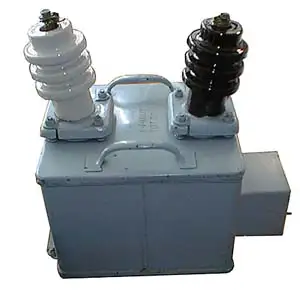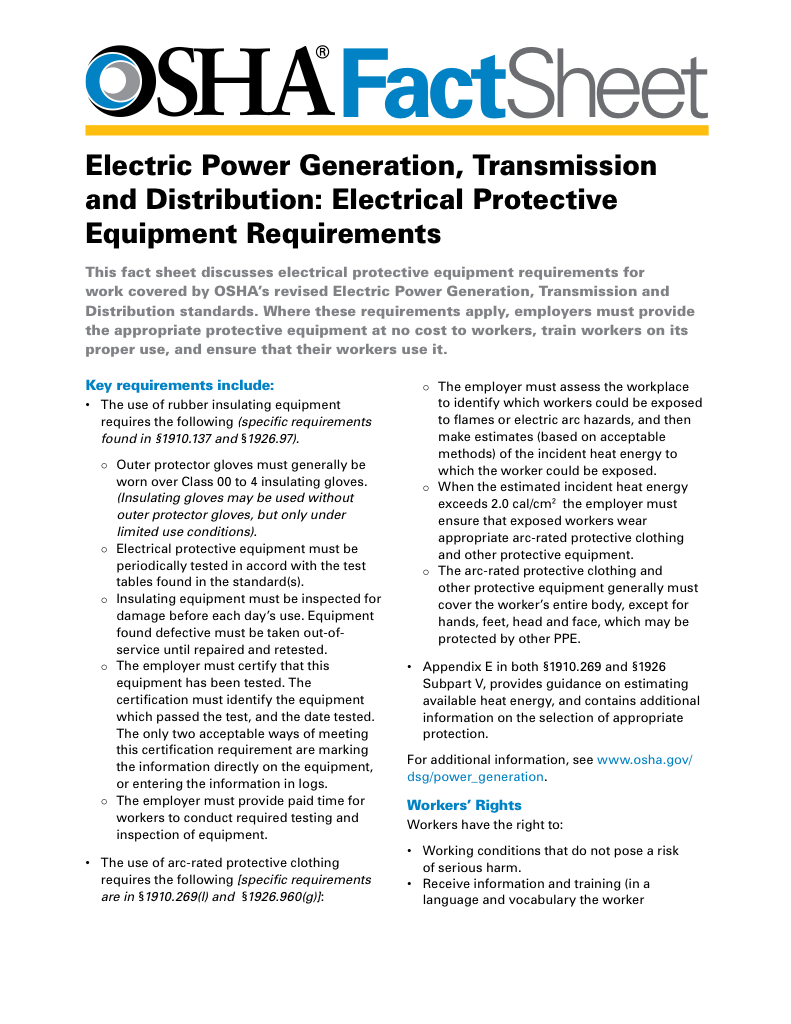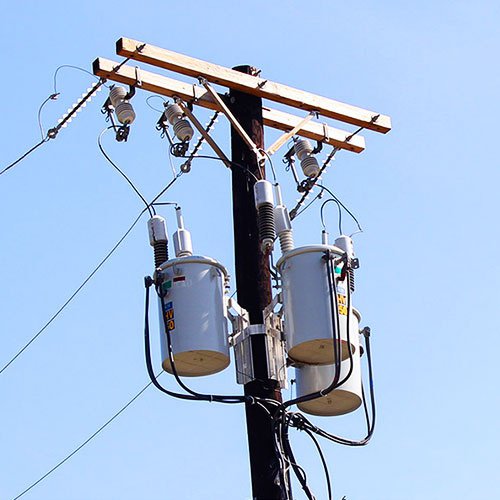Potential Transformer Explained
By Howard Williams, Assocaite Editor

Substation Relay Protection Training
Our customized live online or in‑person group training can be delivered to your staff at your location.

- Live Online
- 12 hours Instructor-led
- Group Training Available
Download Our OSHA 3875 Fact Sheet – Electrical PPE for Power Industry Workers

- Follow rules for rubber gloves, arc-rated PPE, and inspection procedures
- Learn employer obligations for testing, certification, and training
- Protect workers from arc flash and electrical shock injuries
A potential transformer (PT) is a type of instrument transformer used to reduce high voltage to a lower, safer level for metering and protection. PTs ensure accurate voltage measurement in power systems without directly connecting instruments to high-voltage lines.
What is a Potential Transformer?
A potential transformer (PT) is a vital component in electrical power systems that ensures safe and accurate voltage monitoring:
✅ Reduces high voltage to measurable levels for metering and protection
✅ Commonly used in substations and power distribution networks
✅ Enables isolation of measurement instruments from dangerous voltages
Electrical Transformer Maintenance Training
Substation Maintenance Training
Request a Free Training Quotation
A Potential transformer is actually an instrument transformer used in power systems to step down primary current and secondary voltages from a higher level to a lower secondary potential output voltage level. A potential transformer can be easily measured using ordinary low-voltage instruments, such as a voltmeter, wattmeter, and watt-hour meter. This is commonly referred to as a "step-down" voltage transformer, which reduces the voltage of a high-voltage circuit to a lower voltage circuit for measuring voltage drops. Potential transformers are connected across or in parallel to the line being measured to record phase angle errors or ratio errors. To compare potential transformers with similar components, explore our detailed guide on capacitor voltage transformers, commonly used in high-voltage applications.
Construction
The construction of a potential transformer is a testament to the marvels of electrical engineering. These devices consist of carefully calibrated primary and secondary windings, each tailored to achieve a precise voltage ratio. The primary winding, connected to the high-voltage circuit, interacts with the secondary winding through the principles of electromagnetic induction. This design ensures the output voltage is proportional to the input, allowing for accurate voltage measurements. There are different types of potential transformers, including electromagnetic potential types and capacitor voltage and voltage potential transformers. Each type has unique construction features and applications, allowing engineers to select the most suitable design for specific power system requirements. Since PTs are a subtype of instrument transformers, you might also want to learn about current transformers and how they measure high currents safely.
FREE EF Electrical Training Catalog
Download our FREE Electrical Training Catalog and explore a full range of expert-led electrical training courses.

- Live online and in-person courses available
- Real-time instruction with Q&A from industry experts
- Flexible scheduling for your convenience
The working principle of a potential transformer underscores its precision and reliability. Through electromagnetic induction, potential transformers (PT) convert high voltage into a scaled-down version that mirrors the primary voltage. This transformation maintains the voltage ratio and phase relationship, ensuring accurate measurement of voltage. These characteristics are critical for maintaining the integrity of power system operations and safeguarding sensitive equipment.
Accuracy & Burden
PTs are rated by VA burden (e.g., 12.5 VA W-load, 25 VA X-load) and accuracy classes (0.3, 0.6X) per IEEE C57.13. These specifications define performance under load.
Despite their reliability, they are not immune to challenges. Errors, such as ratio errors and phase angle errors, can affect measurement accuracy. Ratio errors occur when the voltage ratio deviates from its intended value, while phase angle errors disrupt the phase alignment between primary and secondary voltages. Addressing these inaccuracies requires meticulous design and regular maintenance to ensure consistent performance. Understanding these errors is critical, as they can have a cascading impact on the system's overall functionality.
Types of Potential Transformers
Potential transformers come in various types, each designed for specific voltage ranges and application requirements in power systems. Learn more about the broad spectrum of transformers, including PTs, in our article on dry-type transformer types.
Electromagnetic Potential Transformer (EMPT):
This is the most commonly used type in medium-voltage applications. It consists of primary and secondary windings on a magnetic core and operates on the principle of electromagnetic induction. EMPTs are ideal for voltages up to 69 kV and are widely used in substations and industrial settings.
Capacitor Voltage Transformer (CVT or CCVT):
Used primarily in high-voltage applications (typically 69 kV to 800 kV), CCVTs step down high voltages using a capacitive voltage divider instead of magnetic windings alone. They are more cost-effective and compact at very high voltages and also provide signal outputs for relays and control systems. CCVTs are common in transmission networks.
Optical Voltage Transformer (OVT):
A newer, digital alternative, OVTs use fibre optics and electro-optic sensors to measure voltage. They offer advantages such as high accuracy, wide bandwidth, and electrical isolation. These are suitable for very high-voltage systems (up to 800 kV) and are increasingly used in smart grid and digital substation applications.
Typical Voltage Ranges:
-
Low to Medium Voltage: Electromagnetic PTs (up to ~69 kV)
-
High Voltage: CCVTs (from ~69 kV up to 800 kV)
-
Extra-High Voltage & Digital Applications: Optical PTs (up to 800 kV and beyond)
Each type plays a crucial role in ensuring accurate voltage measurement, protecting equipment, and monitoring the system across various voltage levels and power grid configurations. Discover how transformer testing is used to ensure accuracy and performance in both voltage and current transformers.
In practical applications, PTs are indispensable. They enable the precise operation of measuring instruments by accurately representing the high-voltage circuit. PTs are also used to protect electrical equipment by isolating measuring devices from the primary voltage, thereby enhancing safety and security. Additionally, they facilitate synchronization between generators and feeders, ensuring seamless operation in substations and throughout the broader power grid. PTs are a cornerstone of efficient power system management by delivering a reliable output voltage.
A potential transformer differs significantly from a regular one. While both devices operate on similar principles, their purposes diverge. Regular types primarily focus on power transfer between circuits, while PTs are dedicated to voltage measurement and monitoring. Furthermore, PTs are designed with higher accuracy to ensure the reliability of measuring instruments, making them vital components in settings where precision is paramount. See how PTs compare to step-down transformers, which also reduce voltage but serve different purposes in power distribution.
Sign Up for Electricity Forum’s Electrical Transformers Newsletter
Stay informed with our FREE Electrical Transformers Newsletter — get the latest news, breakthrough technologies, and expert insights, delivered straight to your inbox.
The distinction between current transformers (CTs) and PTs further highlights their specialized roles. CTs measure current, scaling down high current levels for safe monitoring, whereas PTs focus on reducing high voltage to a lower, measurable level. Both devices complement each other in electrical systems, collectively ensuring comprehensive monitoring and control.
In substations, the potential transformer serves a crucial function. They provide real-time voltage data for system operation, protection, and decision-making. By delivering accurate secondary voltage to control systems, PTs enhance the reliability of substations and ensure optimal performance across the power network.
A potential transformer is a fundamental component of modern electrical infrastructure. Its ability to step down high voltages, provide accurate measurements, and protect systems from harm underscores its importance. It remains an indispensable tool for managing complex electrical systems, whether in substations, industrial plants, or power grids.
If you're looking for a foundational overview of all transformer functions and types, visit our comprehensive page on electrical transformers.
Related Articles







